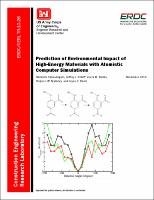Please use this identifier to cite or link to this item:
https://hdl.handle.net/11681/19560| Title: | Prediction of environmental impact of high-energy materials with atomistic computer simulations |
| Authors: | Wayne State University. Department of Chemical and Materials Science Engineering Army Armament Research, Development, and Engineering Center (U.S.) Potoff, Jeffrey Joseph, 1971- Boddu, Veera M. Maloney, Stephen W. Baird, Joyce C. Sokkalingam, Nandhini |
| Keywords: | Environmental impact Energetic materials (EM) Simulation Munitions waste Hazardous waste |
| Publisher: | Construction Engineering Research Laboratory (U.S.) Engineer Research and Development Center (U.S.) |
| Description: | Technical Report Abstract: This work used atomistic MD simulations to predict environmental impact of six energetic materials, 2,4-dinitroanisole (DNAN), N-methyl-p-nitroaniline (MNA), 3,5-dinitropyrazole (DNP), 3-nitro-1,2,4-triazol-5-one (NTO), 1-methyl-2,4,5-trinitroimidazole (MTNI) and 1,3,5-triamino-2,4,6-trinitrobenzene (TATB). Molecular models developed for these compounds were used to determine octanol-water partition coefficient (log Kow) and Henry’s law constant (log H). Log Kow was predicted for DNAN and MNA to within ±0.1 log units of experiment, while log H was predicted to within ±1.0 log units. For the remaining four compounds, no experimental data exist for comparison. Predicted log Kow and log H values suggest that these compounds have the potential to cause groundwater contamination. Depending on the values of the partition coefficients, appropriate treatment methodologies can be chosen for each contaminant of interest. In addition to partition coefficients, a variety of thermophysical properties were predicted, including vapor-liquid co-existence curves, critical points, vapor pressure, heats of vaporization, crystal lattice parameters, and solid density. The crystal density and lattice parameters predicted for all energetic materials were in close agreement with experimental data. Overall, these results suggest that empirical force fields, combined with molecular dynamics simulations, provide an accurate methodology for predicting relevant descriptors of environmental fate for energetic materials. |
| Rights: | Approved for public release; distribution is unlimited. |
| URI: | http://hdl.handle.net/11681/19560 |
| Appears in Collections: | Technical Report |
Files in This Item:
| File | Description | Size | Format | |
|---|---|---|---|---|
| ERDC-CERL-TR-10-26.pdf | 1.01 MB | Adobe PDF |  View/Open |